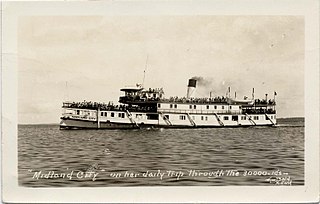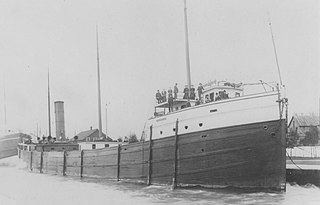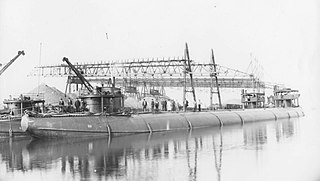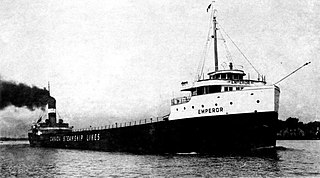
Lake freighters, or lakers, are bulk carrier vessels that operate on the Great Lakes of North America. These vessels are traditionally called boats, although classified as ships.

The SS James Carruthers was a Canadian Great Lakes freighter built in 1913. The ship was owned by the St. Lawrence & Chicago Steam and Navigation Company of Toronto, Ontario, with the official registry number 131090.
SS Arlington was a Great Lakes steamship which was lost in Lake Superior on May 1, 1940.

The SS Hydrus was an American steel-hulled Great Lakes bulk freighter, constructed in 1903 and launched as the R.E. Schuck. She was following the SS James Carruthers heading south on Lake Huron while carrying a load of iron ore when she and the Carruthers were caught in the Great Lakes Storm of 1913.

SS Mataafa was an American steamship that had a lengthy career on the Great Lakes of North America, first as a bulk carrier and later as a car carrier. She was wrecked in 1905 in Lake Superior just outside the harbor at Duluth, Minnesota, during a storm that was named after her. She was built as SS Pennsylvania in 1899, and renamed Mataafa when she was purchased in the same year by the Minnesota Steamship Company. After her 1905 wreck, she was raised and repaired, and served for another sixty years before being scrapped.

SS Midland City was originally a Canadian side-wheel steamboat that provided passenger and cargo transportation on the Great Lakes from 1871 until 1955. Originally named Maud, then America, she underwent several extensive refits over her 84-year service, and saw several owners. The ship was intentionally run aground and burnt to the waterline in 1955 near the mouth of the Wye River in Midland Bay. The wreck is intact and visible above the water to this day, where it acts as a breakwater for the Wye Heritage Marina and local attraction.

SS Ira H. Owen was a steel-hulled American lake freighter in service between 1887 and 1905. One of the first steel lake freighters, she was built in 1887 in Cleveland, Ohio, by the Globe Iron Works Company, and was built for the Owen Line of Chicago, Illinois. Early in her career, Ira H. Owen carried iron ore from Escanaba, Michigan. In April 1898, Ira H. Owen was chartered by the Baltimore & Ohio Railroad. She was sold to the National Steamship Company of Chicago, on December 30, 1899, for whom she frequently carried coal and grain. Throughout her career, Ira H. Owen was involved in multiple accidents and incidents.

Howard M. Hanna Jr. was a 500 ft (150 m) Great Lakes freighter that had a lengthy, 75-year career on the Great Lakes of Canada and America. Hanna was a product of the Cleveland Shipbuilding Company of Cleveland, Ohio. The ship was commissioned by the Richardson Transportation Company to haul iron ore, coal and grain. She had a cargo capacity of 9,200 tons of bulk cargo, or 323,000 bushels of grain.

SS Onoko was an iron hulled Great Lakes freighter. She was launched in 1882 in Cleveland, Ohio as hull number #4, and sank on September 14, 1915 in Lake Superior near Knife River, Minnesota. Onoko is thought to be the prototype for every single steel hulled Great Lakes Bulk carrier that ever sailed. These vessels made possible the cheap transport of bulk cargoes such as iron ore, coal and limestone. Her wreckage still remains on the bottom of Lake Superior and was listed on the National Register of Historic Places in 1992.

SS Choctaw was a steel-hulled American freighter in service between 1892 and 1915, on the Great Lakes of North America. She was a so-called monitor vessel, containing elements of traditional lake freighters and the whaleback ships designed by Alexander McDougall. Choctaw was built in 1892 by the Cleveland Shipbuilding Company in Cleveland, Ohio, and was originally owned by the Lake Superior Iron Company. She was sold to the Cleveland-Cliffs Iron Company in 1894 and spent the rest of her working life with it. On her regular route between Detroit, Escanaba, Marquette, and Cleveland, she carried iron ore downbound, and coal upbound.

The Australasia was a wooden-hulled American Great Lakes freighter that served on the Great Lakes of North America between her construction in 1884 to her burning and sinking in 1896. On October 18, 1896, while loaded with coal, the Australasia sank in Lake Michigan near the town of Sevastopol, Door County, Wisconsin, United States, after burning off Cana Island. On July 3, 2013, the wreck of the Australasia was added to the National Register of Historic Places.

The SS Lakeland was an early steel-hulled Great Lakes freighter that sank on December 3, 1924, into 205 feet (62 m) of water on Lake Michigan near Sturgeon Bay, Door County, Wisconsin, United States, after she sprang a leak. On July 7, 2015, the wreck of the Lakeland was added to the National Register of Historic Places.

Iosco was a Great Lakes freighter that served on the Great Lakes from her construction in 1891 to her foundering on September 2, 1905, when she and her tow, the schooner barge Olive Jeanette sank on Lake Superior. While Olive Jeanette's wreck was located in over 300 feet (91 m) of water about eight miles (13 km) off the Huron Islands in the 1990s, Iosco's wreck has not yet been found.

















